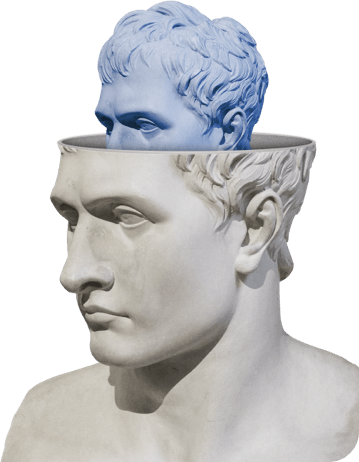Forget customer loyalty, focus on brand assets
-
 Jiri Boudal
Jiri Boudal
- 1. March 2022

How brands grow
Professor of Marketing Science Byron Sharp claims that people who are loyal to a certain brand are very hard to find. On the other hand, those who try every single brand on the market are also not very common.
Most people are loyal switchers – meaning they switch between several brands that are the most salient to them.
According to Sharp, love-brands are a myth. Surprisingly, Apple has lower customer loyalty than Dell. A similar case can be made about any so-called love-brand on the market and Milka is no exception.
(Sharp. 2010. How brands grow)
Everybody’s favorite product
Chocolate is a great product to sell because – who doesn’t love chocolate? Well, actually one percent of Czechs don’t, but that’s just a really small minority. And when it comes to chocolate, Czechs choose Milka the most often.
In the last six months 61% of them bought at least one Milka chocolate bar, which leaves it far ahead of the competition. The second most popular brand is Orion with 43%.
So, we established that Milka is very popular. But does it have loyal customers? It doesn’t. Most of the customer base doesn’t mind tasting other products as well.
76% of Milka customers also bought Orion in the last months, 75% of them bought Kinder, 65% of them got Toblerone and 64% Lindt.
And this kind of behavior is not the exception, it’s the rule.
Salience is the key
95% of all shopping decisions are made in the subconscious. And the most important metric in this case is salience, the quality of being particularly noticeable.
Salient brands will naturally come to the mind of the customer in the moment of their need. The correlation between salience and real buying behavior is very high. And that’s the reason why it’s so important to make your brand stand out.
How is salience measured by behavioral science?
In our research, we place the respondents in a shopping situation and give them a limited amount of time so they can’t think for too long and have to write what comes to their mind immediately and spontaneously. That’s exactly what we need.
Thanks to this method we get answers from the subconscious mind where most of the decisions really happen.

How can a brand increase its sales?
Every brand that wants to grow needs to work on increasing its salience. The crucial process of recalling a specific brand while shopping takes place in the subconscious, and it does not operate rationally.
Fortunately, behavioral science describes some useful aspects about its functioning.
We all keep millions of associations in our memory structure. The associations are connected in the network and help us navigate our everyday choices. We experience an idea coming from nowhere, but in fact the subconscious supplies an answer to the conscious. The associations can originate both in direct experiences with the product or in advertisements. The stronger associations, which people are able to connect to a certain brand, are called brand assets and play a key part in building salience.
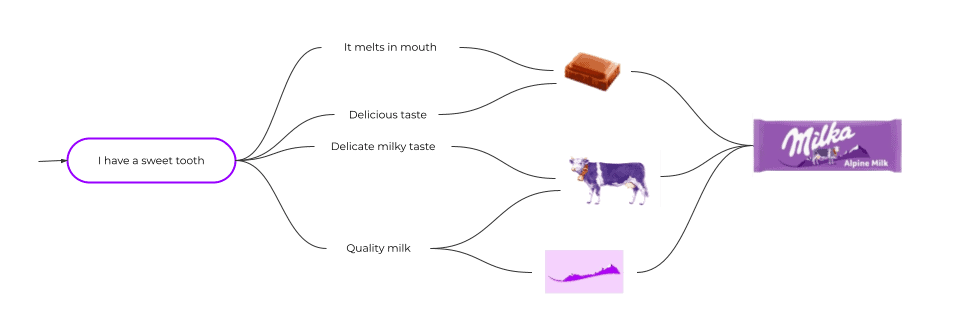
How are brand assets measured by behavioral science?
In our research, we show a brand symbol to the respondents, for example the purple cow, and ask them to quickly connect what they see with different chocolate brands.
If they can’t assign the symbol correctly, it’s most likely not a brand asset.
Or at least not a strong one.
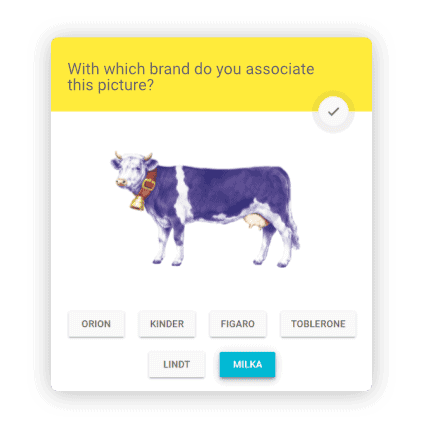
Milka knows its way around brand assets
Almost everybody is capable of recognizing Milka packaging, even with blurred details. And the same is true about the purple cow – 98% of Czechs know without a doubt that it represents Milka. Even the silhouette of a purple mountain range is easily recognizable to most.
How many people pick Milka?
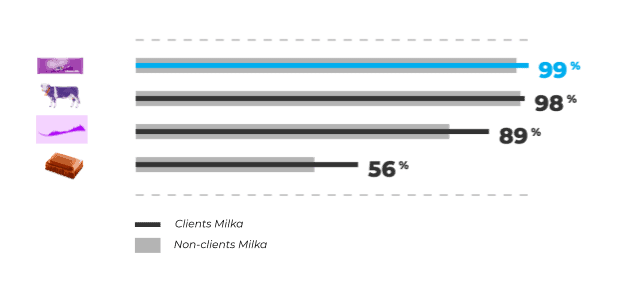
Out of all the tested symbols, the least recognised one for Milka is the shape of the chocolate bar itself.
But that’s not so important, because the competition is using their product appearance in their communication already. For example, Kinder’s chocolate bar shape is a very strong brand asset. Milka is not losing much by not playing on the same field. Brands don’t need to collect brand asset categories like Pokemons – you really don’t gotta catch ’em all.
“Only” 52% of people know immediately that this is how the product looks.
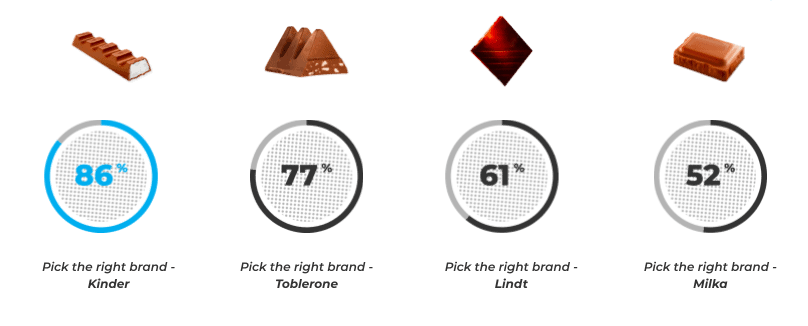
Work on your brand assets
We already proved with data that focusing on loyalty isn’t a good strategy. The loyal switchers won’t change their slutty habits and even the most brilliant marketing strategy can’t chain them to a single brand. Instead of brand loyalty, build brand assets.
It takes a long time for the brain to create the connection between a symbol and a brand.
People need to encounter the symbol many times in various situations for the brain to decide it’s relevant and useful to store in the database. Because of that we strongly advise companies not to get rid of any symbols they have built over time.
That doesn’t mean their marketing has to be completely rigid. On the contrary, we recommend being creative with the symbols, developing them and showing them playfully over all company touchpoints.
Brand assets + needs = the ideal
Brand assets are effectively navigating the needs of customers towards a certain solution. And your company wants to be that solution. When a person feels like having a piece of milk chocolate, the subconscious comes up automatically with Milka in 50% of the cases. Why?
Because you already have connections in the memory structure related to Milka – milk, cow, pure milk from the Alps.
Every brand should research the needs people have when it comes to the product (for example milky taste) and invent brand assets that connect the need to your brand only (a purple cow).
Search for new opportunities
Similarly to binding needs to brand assets, you can also bind them with opportunities. Instead of asking “what do people want from the product” you can also explore the question “when do people use the product”. When do people like to enjoy their chocolate? Is it a popular gift? Is it something you would pack for a vacation? Milka, for example, scores very well as a sweet tooth cure but in the gift category it still has space for growth.
Knowing exactly how people interact with the product can help you come up with an insight for a campaign.
To summarize, don’t try to appeal to your customer’s loyalty, that’s a lost cause.
- Instead, show them new and unexpected ways to think about your product, when and how to use it.
- Respond to their needs.
- And most importantly – communicate all of the above with brand assets.
Current behavioral science doesn’t offer better advice than that.
About the research
- Quantitative research, CAWI
- Data collected January 19–20, 2021
- Sample size of 500 respondents, representative of the Czech online population.


